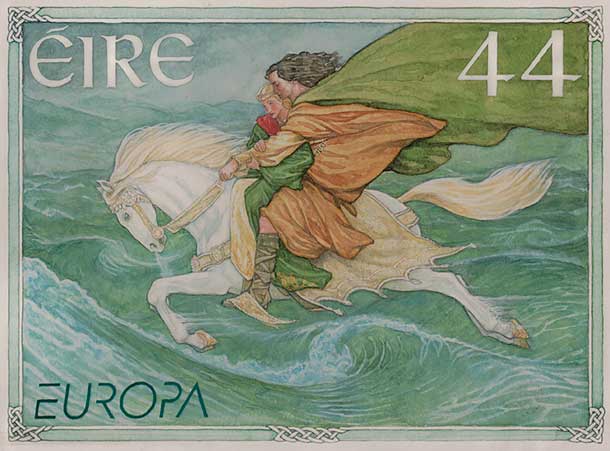 THUNDER BAY – LIVING – A story might start from many places. This one is woven from a summer’s re-reading of The Wanderings of Oisin (pronounced: 0-shean) a legend of ancient times. As I was fortunate in getting to Chicago’s Crossroads of Ireland Art exhibition, this winter, it was there where the Celtic hero Oisin caught my attention again.
THUNDER BAY – LIVING – A story might start from many places. This one is woven from a summer’s re-reading of The Wanderings of Oisin (pronounced: 0-shean) a legend of ancient times. As I was fortunate in getting to Chicago’s Crossroads of Ireland Art exhibition, this winter, it was there where the Celtic hero Oisin caught my attention again.
Where, and when, Oisin travelled to different mythical places it’s the elements within his discoveries that lifts the beauty of his language. That part of his meanderings is so genuinely polished in the poetic manner Oisin has left.
Some clips of his narrative: –“take my tale through words be lighter than air. ”
There is a candid exuberance in that. Trying to convey the lightness and joy in living. Breathing.
Existing. In an atmosphere that makes one praise special moments.
Later, about to discover the beauty of Niamh a woman who will melt his heart. He describes where they first met –“and discovered on the dove-grey edge of the sea.”
Like others who meet Oisin says, by water, “that wavered like the streams of summer.”
Thus, the romance in Oisin’s legend builds.
For though the empathy we may sense encountering other humans who struggle, have a less fortunate persuasion in life than ours, is a touch stone reflection.
Where seeing beggars in a cosmopolitan setting brings back to me the Persian poet Hafiz. Who wrote from his homeland about the same time as Chaucer. Hafiz’s sketch of a pauper translates, “I am the bag lady. I have a spot on every street. My sacks are full of my begging.”
It’s curious while composing this because there was a day one week, not long ago, representing the birthday of the writer Emma Lazarus. Her words inscribed on America’s Statue of Liberty are a direct result of experiencing incredible poverty on the Lower East side of New York. She would make her visits immortal, “give us your huddled masses yearning to breathe free.”
Another author I’d like to mention is Rudyard Kipling. A Victorian. Who surely must may have known the Oisin sagas of wandering. Where Kipling’s Age of Victoria also had a very prevalent aristocratic edge. The kind of separation, in such an elite form, for those of privilege. Yet the
human experience of amalgamating cultural distinctions caused Kipling to say to his son, “if you can walk with kings–yet–keep the common touch. You will be a man my son.”
And so we toil on. Reading Oisin and those he illustrates in the lore of his life.
And another occasion. This time in a library. Researching William Butler Yeats who published his Oisin story in 1899. Out of nowhere there was–at first–a rather alarming almost primitive screech from a middle aged woman standing by a bright window. Looking down on walkers and talkers on the sidewalks of town.
It was a time in the day Kipling’s nation would refer to as the Sundowner hours. Where mellow evening rays on sunshine would soon be sinking on the horizon.
The woman who breached the silence in the library’s reading room was both mute and deaf.
Her impassioned–though benign–squelch was underscored with her hands clapping. Because she became, almost mythically, a vibrant celebration merely viewing common lives of others on the other side of her glass window. Born and foiled with the gift of speech her voice, unable to speak words, was like a songbird whose tune had run out. Vocal cords sandpapered so dry.
She soon resumed her reading. Silently. At her table, The library too resumed its code of silence.
When I stood, lifting a book bag over my shoulder, to catch a bus, both she of us were in eye contact again. As we had before. I smiled. So did she. Instantly she was up from her hardwood chair. She soon smiled so widely, being so near, she hugged me. Then emitted an evocative attempt at a vocabulary. I made it out. “thaan…k…yuU…” And, “gooed…da..da ..day.” We waved in our spacing. I was touched.
Still further on carrying a book of Oisin’s Wanderings–to study in time spaces transferring buses this summer–I returned to our place one night where my wife spoke, in a distinctly moderated voice.
She was the messenger, as in Oisin’s time, bearing news of a death. A lifelong friend had passed on. Our families had shared decades growing together. Such highs and shared lows navigating our lives in the country we call home.
Only a day later at a greenhouse scouting for a tree to plant in his memoriam the one I had spotted was an heavenly image of the unexpected. A mother bird had lifted from its branches.
What she had left was a locally spun nest. In it her summer’s creation of spotted eggs.
How could one buy and move her little kingdom? Before hatchings take their liberty of flying away.
My selection gradually turned to another juniper. Though the passing of a neighbour was The chemistry in making this trip.
It was such a natural metaphor of the journey within this story. Our human birth. Our transcendence to elsewhere. Our careers blossoming from branches of many other trees where we temporarily stopped.
Like the Wanderings of Oisin where the myth, and magic. of what we adore, in literature, in our own seeking duly comes full circle in our human activity of finding how we see others. How they see us? Yet how these understandings translate as reflections of Oisin’s advice, “then (merely) go through your lands in the saddle, and see what other mortals do.”

